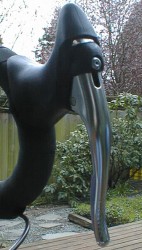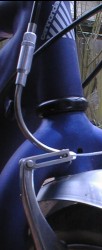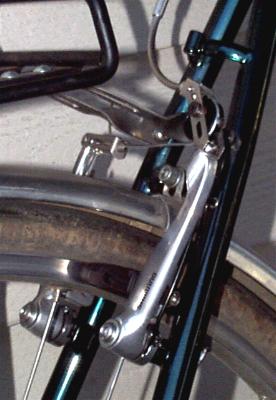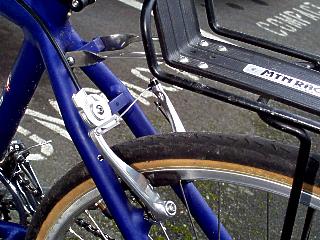Why you should ignore this article
I wrote this article in the late 90s when there weren't many high quality cantilever brakes being made. For touring bikes or other drop-bar bikes with cantilever studs you either had to buy expensive botique brakes, new V-brakes, or used cantilevers. This article talks about how to make the second option workable.
In the meantime many high quality cantilever brakes have appeared on the market. They are designed for the standard aero road brake levers and are very easy to setup. There is no good reason to use V-brakes on most drop-bar bikes anymore. Instead I would recommend getting Avid Shorty, Tektro Onyx, or other affordable yet good cantilevers with a medium profile geometry. I've sold all of the brakes, levers, and adapters shown on this webpage and now use cantilevers on my drop bar touring bikes.
Sheldon Brown has an excellent article on cantilever geometry that is worth reading to get the best setup out of your cantilevers.
Why normal drop-bar brake levers don't work with V-brakes
Shimano recently released a new style of cantilever brake called a direct pull cantilever brake. Its different from existing cantilever brakes in a number of ways, but the one that is relavent here is that it has a higher mechanical advantage then normal cantilever brakes (for further discussion of mechanical advantage and cantilever brakes check Sheldon Brown's article on brake geometry). This means that brake levers used with direct pull brakes must have a lower mechanical advantage (ie, pull more cable) then brake levers design for use with normal cantilever brakes. Without these adapters the brakes would have to be setup to run very close to the rim or the levers would bottom out against the handlebars.
Traditional cantilever brakes in their stock setup also require more cable pull then modern aero road levers supply. However, the cable geometry of the cantilever brake allows one to adjust the mechanical advantage, so that the brakes can be made to work with standard road levers and provide adequate stopping power. This is not true for V-brakes, since the mechanical advantage is fixed.
To use V-brakes on drop-bar bicycles there are three main options available. You can use brake levers designed for V-brakes (the only option available right now is the Diacompe 287-V), or you can use an cable-pull adapter which increases the cable pull of normal road brake levers. There are two such adapters which are commonly available today: the World Class V-dapter and the QBP Travel Agent. The adapters are the only option if you want to use Shimano STI or Campy Ergo combined brake/shifter levers on your bike.
Diacompe 287-V brake levers


The Diacompe 287-V is fairly new to the market. It is the only drop-bar brake lever designed for use with V-brakes. It also comes with a replacement V-brake noodle (shown above) which has an cable adjuster built in.
I'm mostly happy with these levers. They work well, are affordable, and are easier to install and maintain then either the V-dapter or Travel Agent. The braking performance is very good; I can endo the tandem (with no one riding in the rear seat) using the 287-V, LX brakes, and Koolstop Salmon pads. Rear braking performance isn't as good as front braking, but this is due to the long cable used for the rear brake on the tandem, and not a problem in the brake levers or brakes themselves. The main downside to these levers is that you have to set up the pads quite closely to the rims (about 1mm of clearance) for them to work.
The only downside to the 287-V levers is that they can't be used on bikes with Shimano STI or Campy Ergo levers. I don't consider this a problem, since I prefer barends anyway.
Note: These levers are also sold under the brand name DiaTech. I believe that DiaTech and DiaCompe are the same company. My levers came in a box that said DiaTech, but the levers say DiaCompe.
World Class V-dapter

The V-dapter works with Shimano LX and XT V-brakes. I used the LX V-brakes because they are cheaper and have a simpler design. The V-dapter mounts onto on of the arms and has an eccentric pulley to increase cable pull.
The picture above shows the V-dapter mounted on my Trek in the rear. In this case the V-dapter didn't interfere with the rear rack, but it does on many bicycles, so you should check for that before buying one. If it can be used on your bicycle then it generally works pretty well. The only problem that I had with the V-dapter is that it mounts using very small screws that require a 2mm allen key, a tool that I wouldn't normally carry.
Quality Bicycle Products Travel Agent

The Travel Agent is a more recent device then the V-dapter which should work on a wider range of direct pull brakes (although I used the Shimano LX V-brakes again). I used it on my tandem because the V-dapter interfered with the rear rack mounting. It has two concentric pulleys, so that when the cable from the lever pulls on the small pulley it causes the larger pulley to pull more cable through the brakes. An advantage of this system is that it replaces the V-brake noodle, which reduces some of the friction found in the braking system.
I've stopped using the Travel Agent after having a cable break with one. The cable broke at the transition between the inner and outer pulley. It appeared to have been frayed along the edge between these pulleys. This occured after less then 6 months of life on the cable, on my front brake, at the bottom of a long hill. I became nervous about what would have happened if this occured while I was at the top of the long hill, so I've stopped using them. Update: It has been over a year since this occured, and I've only heard of one other cyclist having the same problem (out of many using the same device). While I don't use Travel Agents anymore it does appear that this may not be too big of an issue.